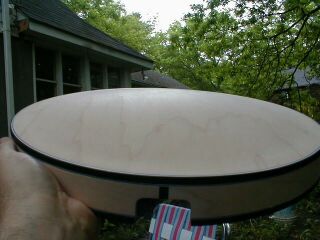
For me, the most uninteresting part of a banjo is probably the finish. I guess that I enjoy playing them and what they look like is not that important to me. I do prefer a satin finish to a glossy because my hand will slide up and down the neck more easily on a satin finish.
I chose to use a Tru-Oil finish on this banjo because it is reported to be very good and easy to apply. Since this is maple, which is a close grained wood, I did not have to fill the pores.
But first, there is the sanding to do before we can even think about applying the finish. Sanding really is a visual activity rather than a tactile one. Long ago, I would sand until the wood felt smooth, but that technique ends with poor results. Now, I sand by looking for the scratches in the wood and erasing them with the paper.
You can see the scratches in the wood if you sight down the side of the wood with a light glancing off of it. Here is a photo of the resonator held up so that the sunlight glances off of the wood.

If you have a good monitor you may be able to just see that there are scratches on the surface where the rough abrasive was used to shape the initial surface. You should at least be able to see that the surface is dull rather than shiny.
Compare that with the following photo:
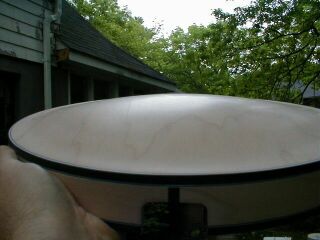
This photo was taken after I had sanded the resonator. You can see that there is already a sheen on the surface of the wood even though no finish has been applied.
My technique is to use paper with increasing grit numbers and sanding with each grade until I have erased all of the scratches made by the previous grade. The grades of paper that I used are:
This is a tedious procedure, but when done, the smoothness of the finish is really on the wood rather than in the finish. The time spent sanding the wood is returned in reduced time required to put on the finish. It takes a lot of self control for me to make myself go through this sanding technique, but in the end the finish comes out much better. I sanded the neck, the pot, and the resonator before I applied any finish. I also steamed the dents out of the pot as best I could using the same technique that I used for the finger board. The dents in the pot were the result of my very first disaster on this project, click here.
Once sanded, I masked off the entire finger board on the neck to keep all the oil off of it. Here is a photo of the fingerboard all masked with masking tape.
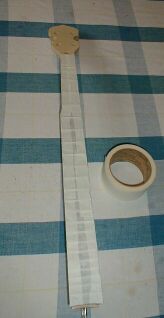
I took the masking tape right down over the binding on the neck:
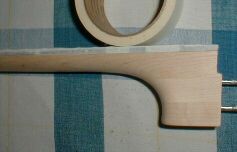
Now I am ready to put on the finish. Here is the bottle of Tru-Oil, which I picked up in the gun section of WalMart.
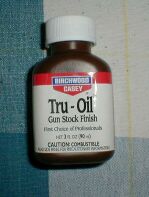
I have no relationship with Birchwood Casey, and I receive no compensation for my comments here about their product.
My method of applying the oil was to put some on a small piece of paper towel and simply wipe into the wood. I had to do this quickly because the oil gets tacky very quickly. I had to cover each piece in a minute or two in order to move the oil around before it got too sticky. Here is a photo of the banjo parts after the first coat of oil.
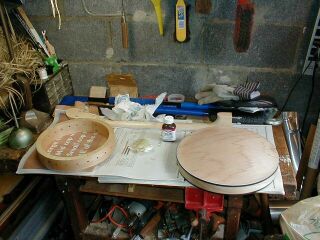
This oil worked very rapidly for establishing a nice finish. Basically, the first coat filled the pores, the second coat provided a satin finish, and the third coat provided a very nice semi-gloss. I suppose that a fourth coat would have made it glossy, but I stopped at three since the finish was just exactly as I wanted it.
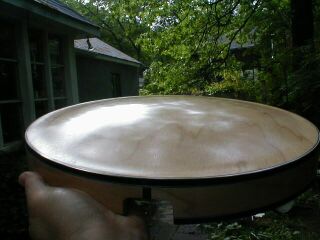
Skip forward a few days. The image above shows the resonator with the finish on it. You can now see the reflections of the trees in it.
I actually put one more coat of oil on the resonator, making four in all. It just did not have the same level of gloss as the other parts did.
This is possibly the easiest finish I have ever applied to a piece of wood. It looks as professional as any finish I have ever seen on any banjo. Very fine stuff.
The oil is very clear. It darkened the wood slightly, but it did not make it yellow like a traditional tung oil or linseed oil would have. The Tru-Oil seems to sit on top of the wood more than the traditional oils.
You guessed it... I turned over the bottle of oil... right onto the neck.
I don't have a photo of the mess that I made, because I was hustling to keep the oil off of the parts that should remain unfinished. So, I grabbed the neck, which had a huge glob of oil on it, and was swimming in a puddle of the stuff, and I rubbed it in as quickly as I could. Since this happened while I was part way through putting oil onto the resonator I then grabbed the resonator and finished it as well. The problem was that the TruOil gets tacky rather quickly, and I barely made it through the oiling of the resonator by the time it became too sticky to work it.
Whew!
But, it all seems to have turned out fine anyway, so I would also not worry about it quite so much... and take back some of the words that I said when I spilled.
I used about half of the Tru-Oil in finishing this banjo, including the spilled oil.